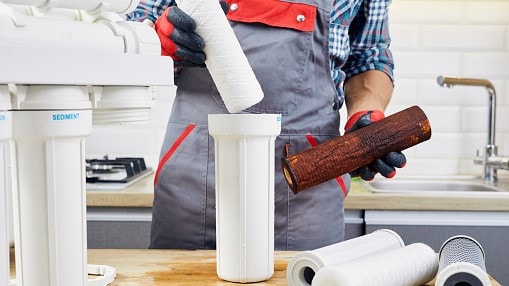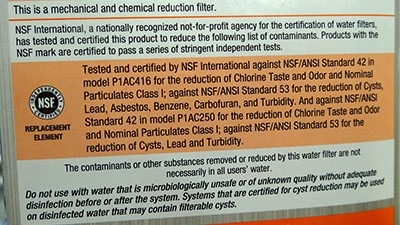Key points
- Water filters can improve the taste of water, the safety of water, or both.
- Test your water and choose a filter that removes the harmful germs or chemicals you are concerned about.
- If your tap water does not contain harmful germs or chemicals, you may not need a filter.

Overview
Different water filters have different functions. Some make your water taste better, others remove harmful chemicals, and others remove certain germs. Filters cannot remove some types of harmful substances, so you may also consider other water treatment systems.
What substances a filter removes from water depends on the:
- Size of the filter's pores (holes)
- Size of the substance
- Electric charge of the substance, which determines whether it will stick to some types of filters
Filters also remove beneficial chemicals
Filters remove both good and bad substances from your water. For example, some filters remove beneficial chemicals like chlorine, which kills germs in water, or fluoride, which prevents cavities. If your tap water is already free from harmful germs and chemicals, you may not want to filter it.
Populations
People with weakened immune systems
If you have a weakened immune system, you are more likely to get sick from germs in water. In particular, the parasite Cryptosporidium may make you sick.
Talk to your healthcare provider and a water disinfection specialist about whether to get a water treatment system. If you do decide to get a system, look for one that will remove Cryptosporidium.
If you have a weakened immune system, avoid changing water filters yourself. Changing filters could expose you to the harmful germs or chemicals caught in the filter.
Tips for choosing a filter
Test your water
Testing your water to find out whether there are harmful germs or chemicals in it will help you choose a filter. If your water is free from harmful germs or chemicals, you may decide you do not need a filter. If your water has harmful germs or chemicals, choose a filter that removes those germs or chemicals.
Well or rain water
If you get your water from a private well or a rainwater collection system, test your water at least once each year for harmful germs and chemicals. Also consider testing your water if you notice changes in color, taste, or smell.
Contact your health department for advice about what to test for and how to find a state-certified lab to do the testing.
Public water system
If you get tap water from a public water system, review the water quality report your utility must provide every year. The report will show if there are harmful germs or chemicals in your water.
Understand pore size
The pore size is the size of the tiny holes in a filter that let water through. Filters work like strainers or colanders. As pore size gets smaller, fewer types of germs and chemicals get through the filter.
If a filter has an absolute pore size of 1 micron, for example, each one of the filter's pores is 1 micron or smaller. This means that anything larger than 1 micron will be caught in the filter and removed from the filtered water.
Filters with a nominal or mean pore size of 1 micron have an average pore size of 1 micron. This means that some pores are smaller and some pores are larger than 1 micron. These filters will let some things that are bigger than 1 micron through the larger holes.

Understand NSF ratings
NSF International is an independent organization that develops public health standards for products. One way to figure out what a water filter removes is to look for an NSF certification on the filter's label. You can look up specific products in the NSF database to see what they are certified to remove from water.
Some of the NSF standards related to water treatment are:
- Standard 42 (taste and odor)
- Standard 53 (cyst reduction)
- Standard 58 (reverse osmosis)
- Standard 62 (distillation)

Consider how much water to filter
Point-of-use filters
Point-of-use filters usually filter water in batches and deliver it to a single tap, such as your kitchen sink. These include under-sink filters and those that attach to your faucet. Consider point of use filters if you only need to filter the water you drink and cook with, for example.
Whole-home filters
Whole-home filters, also called point-of-entry filters, filter water as it comes into your home. This means all your water, from every tap, gets filtered.
Consider these filters if you need to remove a harmful substance, such as certain volatile organic chemicals, from all your water. This includes water you use to bathe or clean with, as well as water you drink or cook with.
Keep in mind that if you install a whole-home filter that removes chlorine or other disinfectants, more germs may grow in your plumbing.
Consider maintenance
You will need to maintain any filter you use to keep it working properly and prevent germs from growing in it. This includes regularly changing the filters according to the manufacturer's recommendations. Wear gloves while you change filters and wash your hands afterward to avoid getting sick.
Some filters also require pre-treating water before you filter it to protect the filter and make sure it works properly. Examples of pre-treating include adjusting pH or adding powdered activated carbon.
Types of filters
Pitcher filters and filters built into refrigerators often use activated carbon filters. Their main purpose is to improve the taste and smell, rather than the safety, of water.
Microfiltration, ultrafiltration, and nanofiltration filters will remove different types of germs depending on the pore size of the specific product.
Reverse osmosis filters remove germs and some types of chemicals.
Improving taste and smell
These types of filters will improve the taste and smell of your water:
- Certified to NSF standard 42
- Activated carbon
Removing germs
Check to make sure the pore size of your filter is small enough to remove the type of germ—such as parasites, amebas, bacteria, or viruses—you are concerned about. Parasites and ameba are larger than bacteria, which are larger than viruses.
Parasites and amebas
Giardia and Cryptosporidium parasites can make you sick if you swallow them. The ameba Naegleria fowleri can make you sick if it goes up your nose, for example while rinsing your sinuses.
These types of filters will remove parasites and amebas from water:
- Certified to NSF standards 53 or 58 for cyst reduction or removal
- Absolute pore size of 1 micron or smaller
- Microfiltration, nanofiltration, or ultrafiltration
- Reverse osmosis
Bacteria
These types of filters will remove bacteria, such as Salmonella or E. coli, from water:
- Absolute pore size of 0.3 micron or smaller
- Ultrafiltration or nanofiltration
- Reverse osmosis
Viruses
These types of filters will remove viruses, such as norovirus or Hepatitis A, from water:
- Nanofiltration
- Reverse osmosis
Removing chemicals
Reverse osmosis filters will remove some types of chemicals from water, including lead, copper, chromium, chloride, and sodium. These filters may also reduce arsenic, fluoride, radium, sulfate, calcium, magnesium, potassium, nitrate, and phosphorous. Check the filter's label for the specific chemicals it can remove.
